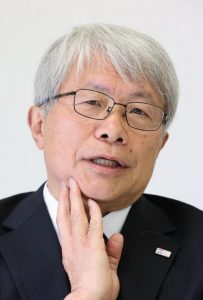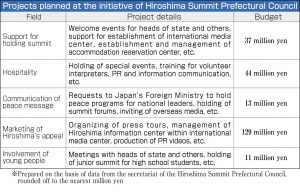Preparations for Hiroshima Summit 2023, Part 5: Interview with Takeshi Yamane, secretary-general, Hiroshima Summit Prefectural Council
Nov. 24, 2022
Building momentum by spreading understanding among local residents
Young people’s experiences to be event’s legacy
by Yoko Yamamoto, Staff Writer
With less than six months remaining before the summit meeting of the G7 (attended by the Group of Seven industrialized nations), to be held in Hiroshima in May 2023, the number of public relations-purposed marketing events has begun to increase. However, leader itineraries, traffic regulations for the event, and other details have yet to be announced. The difficulties inherent in making preparations for the summit on the basis of hypotheticals have come into clear focus. The Chugoku Shimbun interviewed Takeshi Yamane, 64, secretary-general of the Hiroshima Summit Prefectural Council, composed of public- and private-sector organizations in Hiroshima Prefecture, about the current situation and challenges.
More than 200 support projects
What projects is the Hiroshima Summit Prefectural Council promoting?
Communication of information about the summit has gradually taken shape, including an official logo, posters, and a countdown board showing the number of days before the summit is to be held.
The council’s secretariat, which started with half of its staff from the Hiroshima Prefectural government and the other half from the Hiroshima City government, now has 70 members, including those from other local governments and the private sector. The prefectural and city governments continue to equally share expenses. The council’s members are from a variety of organizations and have diverse experiences, but they are energetic and the work environment is positive. The members have been busy promoting the event, with the number of support projects exceeding 200 and still increasing.
What are the challenges?
The most difficult challenge is to proceed with plans for support of the summit while the summit schedule itself is still undecided. The budget for safety is the most expensive, with very little information available about details surrounding security and infrastructure. Expenses for security personnel and related costs are expected to increase, but the size of that budget is not yet clear. Roads have to be improved so long as the possibility exists that leaders will use them.
The necessity of individual projects will be explained by municipalities to the relevant city councils in order to ensure transparency. We are seeking financial support also from Japan’s national government.
The private sector is also making moves, with the Hiroshima Toyo Carp baseball team and the Sanfrecce Hiroshima soccer club refraining from holding games in Hiroshima around the time of the summit.
We appreciate that a variety of sectors are taking appropriate measures, including the postponement of the Hiroshima Flower Festival until June. Going forward, we plan to pass on information about when and where traffic is to be restricted. We may request restrictions on foot traffic to certain parts of Peace Memorial Park, in Hiroshima’s centrally located Naka Ward, as well as the number of school visits to the park.
Minimize impact
It is feared that the summit will greatly impact the daily lives of people around the site proposed for the main venue.
In September, we met and spoke with leaders of neighborhood associations representing the Motoujina area, in Hiroshima’s Minami Ward, about the possibility of issuing ID cards to residents, as was done during the Foreign Ministers’ Meeting, held in 2016. We will have similar sessions to also explain the policy to residents in the areas of Ujinanishi and Ujinahigashi as well as to area schools. We hope to cooperate with the Hiroshima Prefectural Police Department to minimize the impact on people’s daily lives to the extent possible.
What do you hope G7 leaders will do when the summit is held in the A-bombed city of Hiroshima?
We have made five requests of the national government—visit the Hiroshima Peace Memorial Museum, speak with A-bomb survivors, offer flowers at the Cenotaph for the A-bomb Victims, communicate a message of peace, and plant commemorative trees. Those actions would help G7 leaders come into contact with the reality of the atomic bombing with heightened sensitivity. The G7 summit is a significant opportunity to have leaders and related staff visit Hiroshima and see for themselves the recovery of the city after it had been reduced to ashes in the atomic bombing. Our requests will involve high-level political negotiations, but we will patiently stick with our demands.
Looking ahead to the time after the event, what results are you hoping to achieve?
The greatest legacy from the event will be the experiences gained by young people. We are planning to hold a junior summit for high school students as well as international exchange programs. We also need to take measures to promote tourism and outsource the work necessary to objectively calculate the summit’s overall economic impact.
Preparations for the summit still have a long way to go, and people’s awareness about the event needs to be raised further. We hope to accelerate the process by adequately explaining the significance of the event to local communities and bringing about greater understanding.
Profile
Takeshi Yamane
After graduating from the School of Political Science and Economics at Waseda University, Mr. Yamane joined the Hiroshima Prefectural government in 1982. He served as chief of the general affairs bureau and councilor on business strategy before retiring in 2019. Mr. Yamane served in the posts of councilor and director of the Chugoku Regional Innovation Research Center before assuming his current position in July 2022. Born in Asaminami Ward, Hiroshima, he is now 64 years old.
(Originally published on November 24, 2022)









